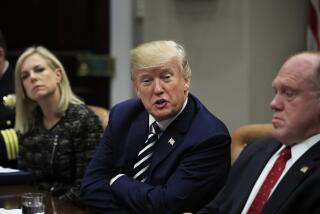Family separations a year later: The fallout — and the separations — continue

Jesus was relieved that he and his 6-year-old had made it safely from Honduras to the United States. Then officials took his son.
He had turned himself and his child in to the U.S. Border Patrol last May after crossing the river that marks the border between Reynosa, Mexico, and McAllen, Texas.
Soon after, he was being interrogated at a detention center by Immigration and Customs Enforcement officers on why he had left Honduras and how he had come to be removed previously from the United States. They told him he was a criminal, he said, and accused him of lying about being the boy’s father.
“They told me that the second I set foot into the United States, the U.S. government owned my son,” Jesus recalled, speaking on condition that his last name not be used.
ICE officers told Jesus to hand over the boy, and when he refused, they ripped him from his arms, he said. The boy tried to hold on to Jesus’ pants, kicking and screaming, but officers held the sobbing father back and put him against the wall, feet spread. His son’s screams faded.
Ten months would pass before the two were reunified.
A year ago this month, the Trump administration chaotically unveiled its family separation policy. After two months of public outcry, President Trump signed an order to end separation. Now, he and some of his closest advisors talk of bringing it back in a new form. But the impact of the first go-round still reverberates from Central America to the White House, from detention centers in Texas to committee rooms in Congress.
Kirstjen Nielsen, the recently ousted Homeland Security secretary, and other officials face subpoenas from House Democrats over family separation. The Homeland Security inspector general’s office has at least two dozen open investigations into border and immigration policy, which the inspector general recently identified as the part of the department at “highest risk” for abuse and mismanagement. And advocates for migrants say the administration has continued to quietly separate hundreds of families using different tactics.
The total number of children separated from a parent or guardian under Trump remains unknown.
In June, U.S. District Judge Dana Sabraw in San Diego blocked family separation and ordered the administration to reunite all separated families within 30 days. The number of separated children in the original class covered by his order ultimately numbered roughly 2,800; more than 400 parents, including Jesus, were deported without their children.
But Homeland Security Department memos, inspector general reports, government data and court documents have shown that administration officials actually began separating families months before then-Atty. Gen. Jeff Sessions’ announcement last April of “zero tolerance” for people crossing the border without authorization, resulting in potentially thousands more separations than previously known.
Recently, administration officials said they would need up to two years to review the cases of 47,000 unaccompanied minors taken into government custody between July 1, 2017, and Sabraw’s June 2018 order to determine how many had been separated from their parents.
“The government is still refusing to take real responsibility for the damage they have done,” said Lee Gelernt, the American Civil Liberties Union’s lead attorney on the family separation case.
Asked Tuesday whether he would bring back family separation, Trump said, “We’re not looking to do that.”
In the next breath, he falsely claimed that President Obama had started the mass separation policy and that he had stopped it — while he simultaneously argued that separation worked as a deterrent.
“Once you don’t have it, that’s why you see many more people coming,” he said. “They’re coming like it’s a picnic, because, ‘Let’s go to Disneyland.’”
They’re coming like it’s a picnic, because, ‘Let’s go to Disneyland.’
— President Trump
After more than two years of failing to achieve his political priority of deterring migration to the United States, Trump is doubling down on harsh policies.
His latest idea, pushed by domestic policy aide Stephen Miller, has been to force parents claiming asylum at the U.S. border to make a “binary choice” between deportation without their children or indefinite detention with them.
Nielsen’s insistence that such a move would violate the law and court orders angered the president and played a key role in his asking her to step down last Sunday. Her allies said she had an updated resignation letter in hand.
Border Patrol agents apprehended 92,607 people in March, the highest monthly total in more than a decade. More than 57% were families, primarily from Central America, with many seeking asylum.
Efforts to deter those migrants have split administration officials.
Jonathan White — the administration’s point person for family reunification efforts at the Department of Health and Human Services, which cares for unaccompanied minors — flatly rejected any suggestion of bringing back zero tolerance.
“I would never support the use of family separation, the systematic traumatization of children, as a tool of immigration policy,” White said Tuesday in a Senate hearing.
White was among the officials who sounded an alarm as early as 2017, when his department observed a “significant increase” in the number of children arriving in its care, apparently separated from their parents. According to court records, other government documents and White’s testimony, he and his colleagues were told there was no policy of family separation.
In truth, the documents show, family separations were taking place then. And despite Trump’s executive order last June, an unknown number of separations have continued, administration officials confirm.
Officials at the border take migrant children away from any relative who is not a parent, but they don’t keep track of those separations. They maintain that those don’t count as family separations, lawmakers say.
The practice could be separating many more children, as many groups arriving at the border include not just children and parents but also older siblings, aunts and uncles, and grandparents often looking to reunite with relatives already in the United States.
U.S. Customs and Border Protection confirmed that any children who arrived at the border with a relative other than a parent were separated and considered unaccompanied. Such cases are categorized as “family relationship in question” and not separately tracked, the agency said.
As part of a long-standing practice, officials also split parents from children in cases in which they can assert the parent poses a danger. Previously, that action was relatively rare. Now that rationale is being cited when a parent has been caught crossing the border before, even though he or she has no criminal record or history of violent behavior, according to lawmakers.
Customs and Border Protection maintains that in such cases separations are required. The agency did not provide data on family separations due to a non-parent’s accompaniment, or a parent’s nonviolent record of reentry, and did not provide further comment.
But officials have cited some of these cases as evidence to back up Trump’s claim that the thousands of Central American families arriving at the border daily are engaging in a “hoax” or “big fat con job.”
Brian Hastings, the Border Patrol’s chief of law enforcement operations, told reporters Tuesday that, from April 2018 to March 25 of this year, his agents had identified more than 3,100 individuals in family units making fraudulent claims, including those who represented themselves as minors but were in fact older than 18.
That’s roughly 1% of all family units apprehended at the border in that period.
Rep. Joaquin Castro (D-Texas), chair of the Congressional Hispanic Caucus, said he had asked officials how many children had been separated from relatives other than parents, or from parents with a reentry record and no other disqualifying factors, but they had yet to provide the numbers.
“They don’t want anybody to hold them accountable,” Castro said. “You have an administration determined to get away with what they can and to test the legal limits.”
Nielsen might be gone, but her forced exit and the president’s latest flirtation with family separation probably will fuel continuing investigations.
Rep. Elijah E. Cummings (D-Md.), chair of the House Oversight Committee, said the Trump administration had refused to comply with requests for information on family separation, forcing the committee to subpoena Nielsen, Atty. Gen. William Barr and Health and Human Services Secretary Alex Azar. The administration has yet to hand over the full set of requested documents, he said.
The committee’s vote to issue subpoenas was bipartisan, underscoring frustration even among some Republicans.
Rep. Chip Roy of Texas was one of two Republicans on the committee to vote to subpoena Nielsen.
“It’s important to send a message to the administration,” Roy said. “I’d like to know what happened on the child separation issue. … I haven’t seen everything I need to see.”
Sen. Ron Johnson (R-Wis.), chair of the Senate Homeland Security Committee, said his panel would unanimously oppose bringing back family separations.
“I think the administration found out that’s just, first of all, politically unsustainable,” he said.
Lawmakers and the inspector general already wanted to know how the family separation policy came about, what its effects were, and whether Nielsen and others were untruthful in sworn congressional testimony. Now Trump has left them to grapple with whether the administration ever truly intended to end the policy.
Rep. Bennie Thompson (D-Miss.), chair of the House Homeland Security Committee, has worked with every Homeland Security secretary since the department was created in 2002 and says the Trump administration’s slow-rolling of oversight is unprecedented.
On Wednesday, he put Kevin McAleenan, the former Customs and Border Patrol commissioner and new acting head of Homeland Security, on notice, repeating a request for documents on family separation dating to January.
John F. Kelly, Trump’s first Homeland Security secretary and former chief of staff, defended the administration and Nielsen’s actions on family separation, saying that Sessions surprised everyone with his zero-tolerance announcement.
“Now, the president may have decided to do it anyway,” Kelly said in an interview just before he left the White House at the end of last year. “But I can tell you, he was not filled in.”
An administration official, speaking on condition of anonymity, denied that, saying Sessions took the fall for a policy that had been discussed internally for months.
The official predicted that the controversy over family separation — “still a front-page, loud issue” — would continue to dog the White House. “It’s almost like Mueller-level interest,” the official said, referring to special counsel Robert S. Mueller III and his investigation of Russian interference in the 2016 election.
For now, Jesus and his son are with a U.S. sponsor, and his family is applying for asylum together. But the trauma remains. “He cries for almost everything,” Jesus said. “My son is not the same as before.”
Twitter: @mollymotoole
More to Read
Get the L.A. Times Politics newsletter
Deeply reported insights into legislation, politics and policy from Sacramento, Washington and beyond. In your inbox three times per week.
You may occasionally receive promotional content from the Los Angeles Times.







